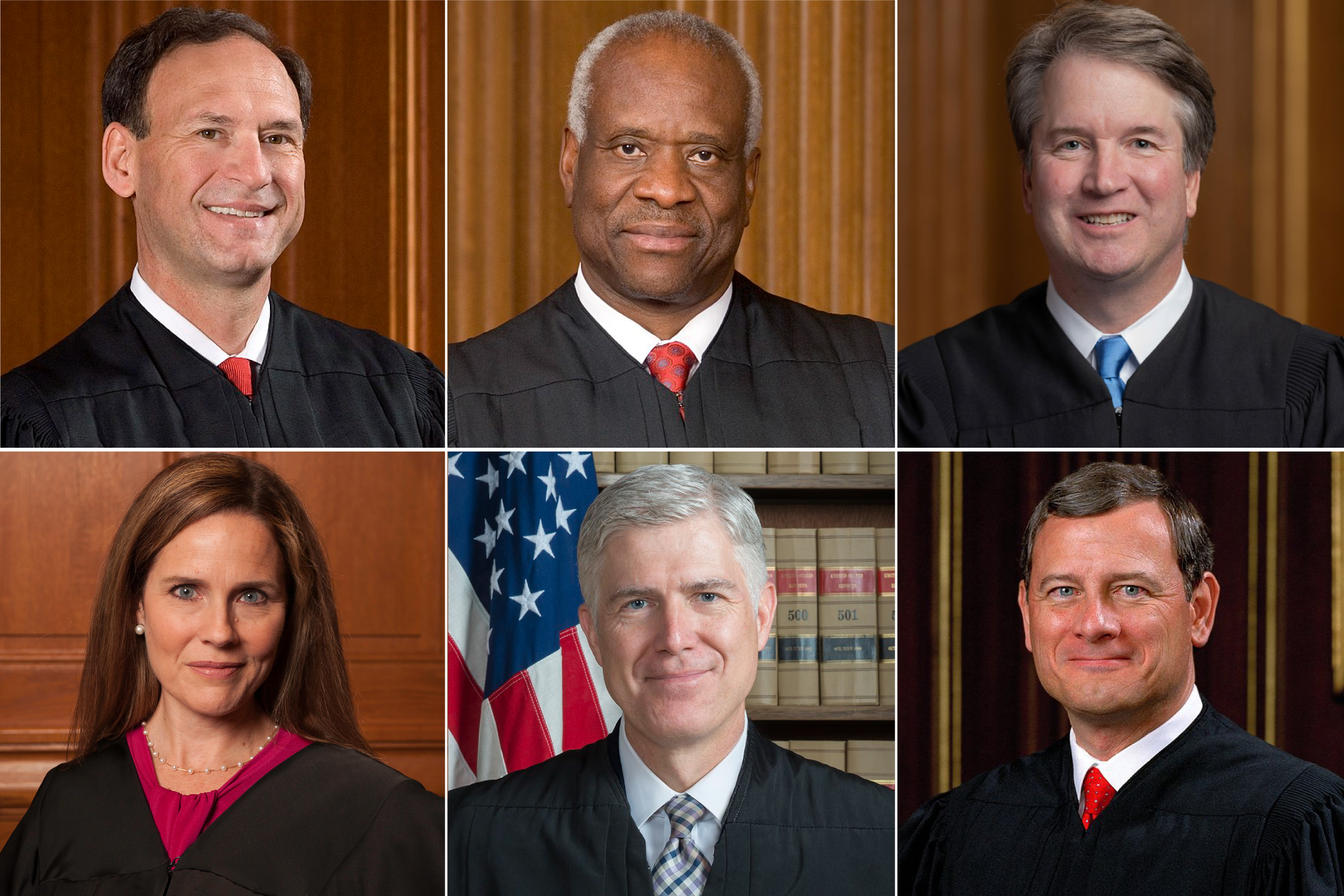
Supreme Court Justices with Federalist Society ties: (clockwise from upper left) Samuel Alito, Clarence Thomas, Brett Kavanaugh, John Roberts, Neil Gorsuch, and Amy Coney Barrett.
The conservative club that came to dominate the Supreme Court
In a new audiobook, Law School professor explores the rise of the Federalist Society and why its sway may be waning
Beginning in the early 1980s, when it was not exactly cool to be a conservative law student, a small group of students started a club, named in honor of The Federalist Papers, where they could safely discuss their right-of-center views. Fast-forward 40 years and six of the nine sitting Supreme Court Justices are current or former members of that club.
In “Takeover: How a Conservative Student Club Captured the Supreme Court” (Pushkin Industries), Harvard Law School professor and “Deep Background” podcast host Noah Feldman explores the rise of the most influential legal organization in U.S. history and how it has managed to shape judicial policy over the last three decades.
Feldman, one of the four legal scholars called upon to testify at the first impeachment hearings on former President Trump, with “Deep Background” co-host Lidia Jean Kott, takes listeners into the offices and chambers of the people who know the organization best.
Listen to the preface and start of Chapter 1, “How to Start a Revolution.”
transcript
Transcript:
RBGmontage…
Reporter 1: Now a time for mourning for a remarkable career and life well-lived.
Reporter 2: U.S. Supreme Court Justice Ruth Bader Ginsburg has died at the age of 87.
Trump: I stand before you today to fulfill one of my highest and important duties under the United States Constitution, the nomination of a Supreme Court Justice.
Preface
Noah Feldman: When Justice Ruth Bader Ginsburg died in September 2020, I knew one thing for sure.
The person that Donald Trump would nominate to replace her would be affiliated with a powerful organization called the Federalist Society.
As a constitutional law professor at Harvard University, I spend a lot of my time watching the Supreme Court — it’s a big part of my job. But this prediction did not take much in the way of high-level expertise.
The two other Supreme Court Justices that Trump had already appointed, Neil Gorsuch and Brett Kavanaugh are both affiliated with the Federalist Society. So are 80% of the judges that Trump had already appointed to the courts of appeals.
The Federalist Society is a club for conservative and libertarian lawyers. It’s focused on promoting conservative legal thought and on filling the American judiciary with like-minded allies.
It was founded about 40 years ago by a bunch of law students, nerds really, who felt ostracized on their law school campuses because of their conservative views.
Since then it’s grown to become the most influential legal organization in the United States ever, capable of dramatically redefining American jurisprudence for decades to come.
And sure enough Trump nominated Judge Amy Coney Barrett, who is closely affiliated with the Federalist Society:
CLIP
Barrett: I am honored and humbled to appear before you today as a nominee for associate justice of the Supreme Court.
With Amy Coney Barrett now on the Supreme Court, six of the nine Justices are current or former Federalist Society members.
This book, adapted from a series on my podcast Deep Background, is the story of what the Federalist Society stands for, how it took over the Supreme Court, and why now that it has achieved extraordinary success, it may actually be about to fall apart.
Chapter 1: How To Start a Revolution
Let me take you back, now, 40 years exactly, to the fall of 1980.
At that time it was not exactly cool to be a conservative law student.
CLIP
Gary Lawson: The atmosphere was, here’s the best way I can describe it.
Any time a student in class said anything that could remotely be considered right of center a good chunk of the class would hiss.
That’s Gary Lawson. He’s now a law professor at Boston University. At the time, though, he was a first year law student at Yale.
And yes, you heard him right, he said hiss.
CLIP
Lawson: Literally vocal hisss, in fact one of my counter-lines to that, “Is something wrong with the heating system?”
And it wasn’t just that most law students and professors were liberal, arguably aggressively so.
The Supreme Court was, too.
For the previous few decades, there had been a liberal majority on the Supreme Court, led by lions like William Brennan and later Thurgood Marshall. The Court had made a series of transformative decisions that had a profound impact on the country.
Of course, there was Brown against Board Education, argued by Thurgood Marshall before he actually became a Justice, where the Supreme Court ruled that school segregation was unconstitutional.
But there were others too — the Court held that Bible reading in public school was unconstitutional. It ruled that criminal suspects had to be informed of their right to remain silent before custodial interrogation, the famous Miranda decision. And, in the landmark case of Loving against Virginia, the Court said it was unconstitutional for the state to ban interracial marriage.
Then, in 1973, shortly after Chief Justice Earl Warren retired and Chief Justice Warren Burger took over:
CLIP
Number 70, 18 Roe against Wade.
For liberals, these decisions were a march of progress.
But conservatives thought the Supreme Court Justices were going beyond their mandate to uphold the law.
Ronald Reagan agreed.
And maybe the public did too, because on November 4th, 1980, Reagan won the presidency — in a landslide.
Visit Pushkin.fm for more details.






